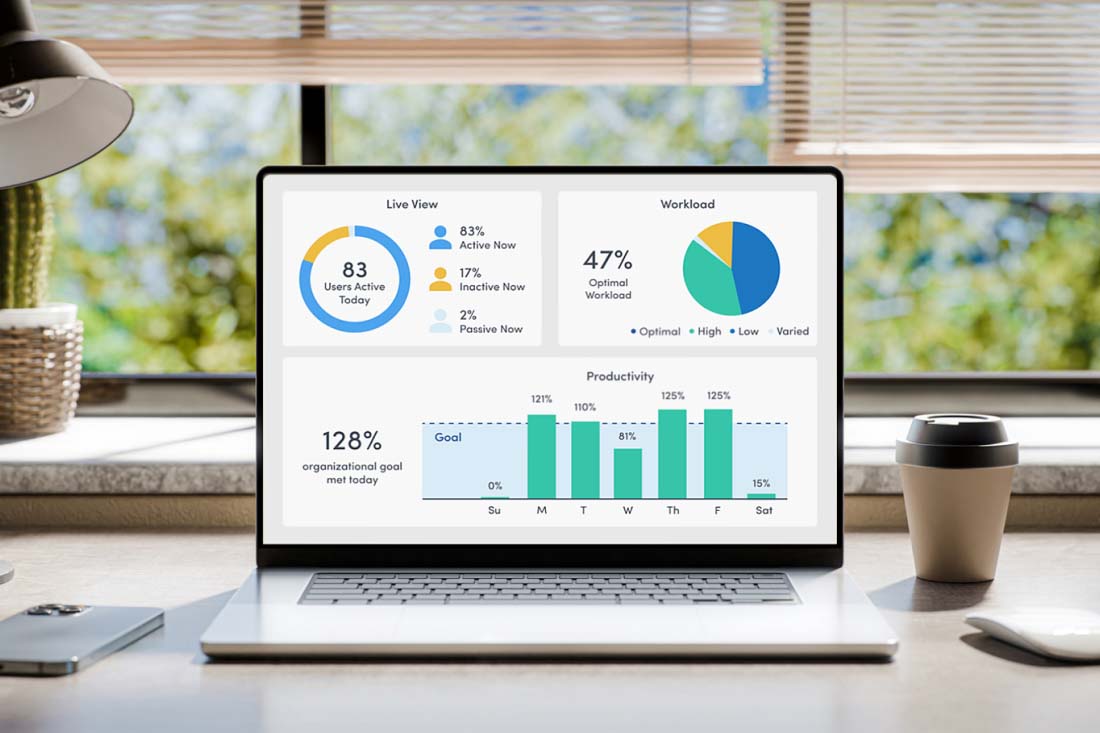Monitoring employee performance has become an increasingly important aspect of staying competitive. Effective employee performance monitoring not only helps uncover areas where employees and processes can improve but also plays a major role in driving business success.
In this post, we’ll share seven strategies for monitoring employee performance along with insights on how performance monitoring can benefit both employers and employees.
7 Ways to Monitor Employee Performance
Employee performance monitoring helps ensure your organization can consistently track and evaluate how employees handle the responsibilities of their roles and progress over time. To get the right data, managers can use one or more of the following seven methods to gather performance insights:
1. Perform regular check-ins and one-on-one meetings
Team leaders should be encouraged to check in regularly with their employees. Scheduling regular one-on-one meetings is a great way to monitor employee performance in a more casual format. Managers should schedule regular meetings with their employees to discuss progress, address concerns and provide guidance. These meetings help maintain a transparent feedback loop and foster a positive working relationship between managers and employees. When they’re scheduled regularly, these meetings serve as a means of employee performance monitoring and help ensure employees and managers are on the same page prior to year-end reviews.
2. Use performance management software
Using performance management software streamlines the performance monitoring process, making it more efficient and effective. These software solutions help organizations set goals, track progress and monitor employee performance in a centralized system with data to back up decisions. By automating routine tasks like performance reviews and feedback documentation, these tools free up valuable time for managers and HR professionals.
3. Implement employee monitoring software
Talking about performance on a regular basis and setting goals can help motivate employees, but monitoring employee performance using software can provide hard data to help guide the conversation. It’s important to find a platform that provides the kind of monitoring insights you need to understand how your employees are performing while maintaining their privacy. These tools help improve productivity by showing where roadblocks are hindering progress — giving employees and managers the tools to fix productivity issues. The type of employee monitoring software you choose to implement depends on the type of work your company does and what your measures for success are.
4. Integrate peer reviews and 360-degree feedback
Peer reviews and 360-degree feedback provide valuable insights into employee performance from multiple perspectives. 360-degree feedback is a method where employees receive confidential evaluations from their direct colleagues, including those who manage them and others. Management is also evaluated by the employees they lead. By involving colleagues, subordinates and managers in the evaluation process, organizations gain a holistic view of an employee’s strengths and areas for improvement.
In fact, a Gallup study of 530 workers found that teams with managers who received strengths feedback showed 12.5% greater productivity post-intervention than teams with managers who did not receive feedback. A similar study by Gallup found that managers who received strengths feedback showed 8.9% greater profitability post-intervention compared to managers who received no feedback. These findings and others prove the value of strengths feedback not just as a means to collect information about employee performance, but also to improve it.
5. Utilize self-reported surveys
One way many organizations can monitor employee performance is by asking employees how they think they’re doing. While there are tools that can measure engagement, getting to know how your staff feels from their own mouths can improve employee engagement significantly. Self-reported surveys can give employees the chance to speak their minds about their performance and that of their direct colleagues, as well as their overall understanding of how their work aligns with company goals.
There are some limits with these surveys, especially if they’re not anonymous. Employees may censor themselves to appear more compliant with company politics or out of fear of losing their jobs for appearing to be negative. At the same time, without objective data to base their responses on, employees may not have good discussion points. Surveys need to be professionally scripted and carefully worded to ensure employers get the information they’ll really be looking for while giving employees a place to communicate truthfully.
6. Create incentives to participate
Some employees may be hesitant to participate in performance monitoring programs for fear of micromanagement or scrutinization, but rewards can be a good incentive to join. You can emphasize that performance monitoring will help employees get rewards in the form of raises, promotions or bonuses. Not only will employees be able to track their progress so they can see if they’re on pace to hit goals tied to incentives, but it will also help managers know who needs extra support and in which areas to help employees hit those goals. Additionally, having more data about performance can help managers make a stronger case to leadership when advocating for their employees to get these incentives.
7. Listen to what your employees are saying and doing
An easy tool to use in employee performance monitoring is your own eyes and ears. Many employees might not be willing to open up about issues in front of management, but your own powers of observation can often give you a real sense of how employee performance is faring. Engaging with employees in casual settings can help you get a better sense of how they feel about company goals and performance.
For remote-based teams or hybrid teams, managers can pay close attention to conference calls or messaging channels. Still, managers can lean on remote workforce management tools to get a better understanding of employee performance. Taking the time to observe employees without judgment and seeing if your observations line up with other performance metrics can help you find issues that may not be immediately obvious.
Monitor Your Employees’ Performance with ActivTrak
Employee performance monitoring can help your organization create long-term goals and find a path toward accomplishing them. ActivTrak can help provide data on how employees are doing, what tools they’re using, how much time they’re spending on tasks, and where they may need more support. The ActivTrak platform gives you insight into daily work activity and long-term productivity trends. It can also help leadership spot signs of burnout or disengagement to help employees create a healthy workload balance.
Contact us to see how we can help you monitor employee performance and gain meaningful insights to guide your company’s performance management decisions.





